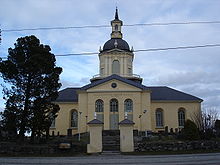Alatornio
Alatornio [ ˈɑlɑtɔrniɔ ] ( Swedish Nedertorneå ) is a former municipality in Finland and now part of the city of Tornio .
history
The parish of Alatornio was created in 1606 when the parish of Tornio was divided. It covered the lower reaches of the Tornionjoki (Torne älv). Hence the name Alatornio / Nedertorneå (“Nieder-Tornio”). The upper reaches of the river belonged accordingly to the parish of Ylitornio / Övertorneå ("Obertornio"). In 1621 the town of Tornio was founded on the island of Suensaari near the mouth of the river and detached from the parish of Alatornio. In 1745 Karunki became its own parish.
When the area of today's Finland became a grand duchy under Russian rule in 1809 , the Tornionjoki became a border river. About a third of Alatornio remained on the Swedish side and was further called Nedertorneå. The Swedish municipality of Nedertorneå existed until 1967 when it was merged with the city of Haparanda and the municipality of Karl Gustav to form the municipality of Haparanda .
In the course of the 20th century, areas from the municipality of Alatornio were added to the city of Tornio several times: in 1925 parts of the village of Pudas, in 1944 the railway area of Pudas and in 1957 the rest of the village of Pudas, the village of Röyttä including the seaport, part of Pirkkiö and smaller parts the villages of Kiviranta and Yliraumo. In 1973 the entire municipality was incorporated into Tornio together with the municipality of Karunki.
geography
The southern part of the rural area of the city of Tornio, which was originally limited to the river island of Suensaari , belonged to the municipality of Alatornio . The historic church village of the municipality is the place Pirkkiö, today a district of Tornios. Here, in the Kirkonmäki district, is the church of Alatornio . In its current form, the classicist building with the floor plan of a Greek cross with equal arms was created in the years 1794–1797, but it goes back to a medieval stone church from around 1500, which was built into the eastern cross arm. In addition to the Old Church of Keminmaa , the Church of Alatornio was the northernmost of Finland's medieval stone churches.
In addition to Pirkkiö, the municipality of Alatornio included the following villages: Alaraumo, Alavojakkala, Arpela, Kaakamo, Kantojärvi, Kiviranta, Kuusiluoto, Könölä, Laivajärvi, Laivaniemi, Liakka, Luotomäki, Pudas, Ruottomäki, Yliraumo, Ylivojakkala.
literature
- Heikki Rantatupa: Alatornion historia . Tornio 1988.

